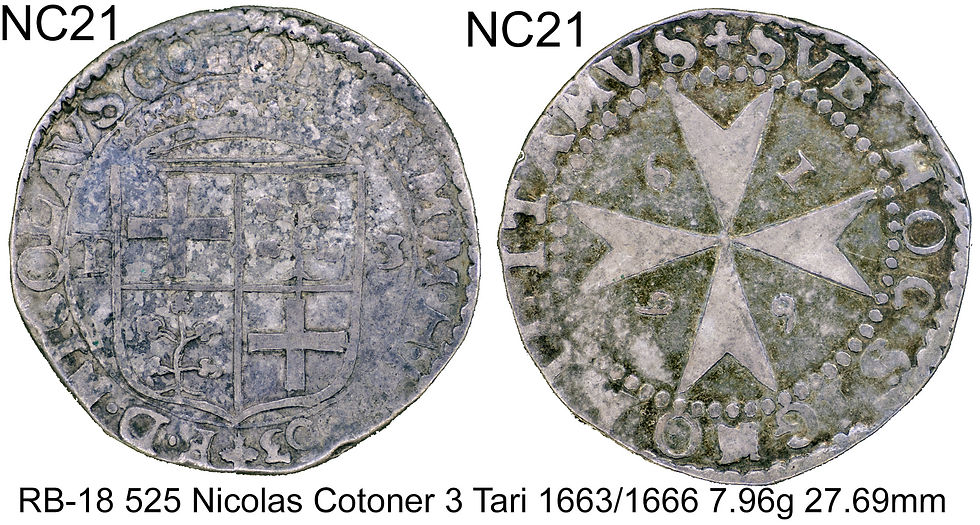The greatest mistake is to imagine that we never err - III
- Malta Numismatic Society

- Jan 22, 2022
- 3 min read
a) Die Setting Errors
Die setting errors are errors caused by the person setting the equipment or the press before the minting process. Prior to the screw press, all coins were minted by hand using a handheld hammer die (top die) and a fixed anvil die (bottom die). The anvil die was generally secured into a log of wood.
The anvil dies generally lasted three to four times longer than the hammer die. So, besides the occasional incorrect die being used, there was no actual setting required.
But there are some stunning errors to be found like the two Nicholas Cotoner 3 Tarì coins that have a different date on each side
1. GATT 18-3T-01X01 having 1663 on the obverse and 1664 on the reverse

2. GATT 18-3T 01X21 having 1663 on the obverse and 1666 on the reverse

With the introduction of the screw press, both dies were placed in a die-housing, the top die still being called the hammer die and the bottom die still being called the anvil die and placed at the bottom of the press.
Some of the actual dies from Grand Masters De Rohan and Hompesch still remain, and I was allowed to photograph them in 2017. By that stage the shafts of the dies were hexagonal in shape to prevent them from rotating in the die housing. Based on information about the rotation of the Perellos Grano it seems that in the early days of the screw press the die shafts may have been round and the top and bottom die housings may have been interchangeable. I do not have any definite proof of this, but there are a few mules of the 1703 Perellos Grano which I have seen. I assume that in later minting this error was rectified as they have only been seen in the 1703 coins. There are two other mule Grano, a Pinto 1743 Grano and a De Rohan 1785 Grano. These two coins are both in St Johns Ambulance Museum in London.
I became suspicious of the De Rohan 1785 Grano coin after I realised that both sides of this coin are made from the same die, which is impossible. So, I phoned the museum’s curator and told him my concern and asked him whether he could see a join along the edge of this coin. He confirmed that there was a join indicating that two coins were used to fabricate this coin. As the 1743 coin has two different dies, I never queried about this coin, but now I believe it could be the same as the 1785 coin. I hope to confirm this the next time I visit the museum.
The only other type of die setting error is where a die is incorrectly placed in the die housing and the rotation of that variety is incorrect. By Pinto’s reign the minting process was becoming standardised. The 30 Tarì coins are normally seen with a coin rotation. Of the 93 different Pinto 30 Tarì varieties only one 1757 variety, the GATT 25-30T-43M06 is seen with a medal rotation. As both these dies, obverse 43 & reverse 06 are seen with other die combinations, this must have been a die setting error.
Note: Mules occur when two miss matched dies are used to mint a coin. In both the two 1703 Grano mentioned these had two reverse sides. These should not be confused with Brockage Coins, where the same design is seen on both sides, but one side is reversed. These will be covered in the third post.
by John Gatt
www.coinsofmalta.com













Comments